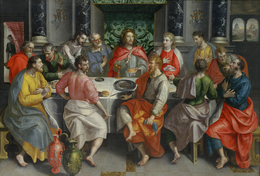更新日 2025.02.28 | 28 February 2025
現在は展示していません

現在は展示していません。
Marten de Vos
Antwerp, 1532 - Antwerp, 1603
最後の晩餐 The Last Supper
| 材質・技法・形状 | 油彩、カンヴァス |
|---|---|
| 寸法(cm) | 146 x 212.5 |
| 署名・年記 | 右下、椅子の上に署名: F. M. D. Vos |
| 分類 | 絵画 |
| 所蔵番号 | P.1992-0004 |
マールテン・ド・フォスはブリューゲルとルーベンスとをつなぐ時期に活躍した最も重要なフランドルの画家である。1550年代にはイタリアに滞在したと思われ、確証こそないものの、ティントレットの工房で活動したとも推測されている。ド・フォスの活動したアントウェルペンは、1581年から85年にかけてのカルヴァン派の一時的な支配の後、再びカトリックの支配下に入った。この時期のアントウェルペンでは、言うまでもなくカルヴァン派信徒たちによって荒廃させられた諸聖堂の再興が最重要課題となっており、それは対抗宗教改革運動とも密接に連動していた。自らも新教徒であったド・フォスは、1560年代から70年代は主として富裕な商人たちのために絵画を制作していたと思われるが、宗教上のこうした激変によっておそらくはカトリックへの改宗を余儀なくされ、90年代以降は教会を飾る祭壇画を多数制作するようになっていった。 ド・フォスは伝統的な形式に従って画面とほぼ平行にテーブルを配置し、中央奥にキリストを、彼を取り囲むように弟子たちを描いている。自分たちのうちのひとりが主を裏切ると告げ知らされたことにより、弟子たちの間には動揺が広がる。本作品はまさにその瞬間を描いているように思われる。弟子たちは視線の向きと配列の工夫によりいくつかのグループにまとめられているが、こうした構成において裏切り者であるユダの孤立もまた巧みに演出されている。弟子たちが全員イエスの方を見つめているか、仲間同士で語り合っているのに対し(例外は画面を見る観者のほうに視線を投げかける人物であるが、これは構図上の工夫であろう)、ユダひとりがイエスの正面に位置しながら、まるでその視線を避けるように挑戦的に横を向いている。けれども、裏切りという劇的なドラマにもかかわらず、画面全体は抑制された静かな表現に支配されている。この静的性格は、「最後の晩餐」の主題が本来もっている、聖餐という宗教的意味の強調に由来するのだろう。なお、ド・フォスの手になる《最後の晩餐》として少なくとも3点の作品が知られている。(出典: 国立西洋美術館名作選. 東京, 国立西洋美術館, 2006. cat. no. 25)
来歴
Sale, Hôtel des ventes, Dijon, 18 November 1990; Didier Aaron, Paris; Purchased by the NMWA, 1993.
展覧会歴
- 1996
- 東京国立近代美術館・国立西洋美術館所蔵作品による 交差するまなざし: ヨーロッパと近代日本の美術, 東京国立近代美術館, 1996年7月20日-1996年9月8日, cat. no. 74
文献歴
- 1992
- Didier Aaron Catalogue. Paris/London/New York, 1992, cat. no. 1.
- 1996
- 国立西洋美術館年報. Nos. 27-28 (April 1992-March 1994), 1996, 中村俊春. 新収作品. pp. 13-19, 新収作品一覧. p. 69, col. repr.
- 2006
- 国立西洋美術館名作選. 東京, 国立西洋美術館; 東京, 西洋美術振興財団, 2006, no. 25, col. repr.
- 2009
- Masterpieces of The National Museum of Western Art, Tokyo. Tokyo, The National Museum of Western Art; Tokyo, The Western Art Foundation, 2009, no. 25, col. repr.
- 2013
- 国立西洋美術館名作選. 東京, 西洋美術振興財団, 2013, no. 24, col. repr.
- 2018
- 幸福輝. 国立西洋美術館オランダ絵画・フランドル絵画カタログ. [東京], 国立西洋美術館; 西洋美術振興財団, 2018, pp. 50-52, no. 10, col. repr.

Currently not on display
The Last Supper
| Materials and Techniques | oil on canvas |
|---|---|
| Size(cm) | 146 x 212.5 |
| Inscriptions | Signed lower right on the chair: F. M. D. Vos |
| Credit Line | Purchased |
| Category | Paintings |
| Collection Number | P.1992-0004 |
Marten de Vos was the most important Flemish painter active in the period linking Brueghel and Rubens. It is thought that de Vos lived in Italy during the 1550s, and there is some unproved supposition that he may have been active in Tintoretto's workshop. De Vos was primarily active in Antwerp and after a period as a Calvinist, from 1581-85, he returned to the Catholic faith. During this period in Antwerp the most important work for painters was the restoration of the various churches destroyed by the Calvinists, and such restoration work was closely linked to the Counter-Reformation religious movement. Himself a Lutheran, de Vos is thought to have painted works for wealthy merchants during the 1560s and 1570s, and inevitably the religious upheaval of the time led to his reversion to Catholicism. From the 1590s onwards he is known to have created a large number of altarpieces to adorn Catholic churches. Here de Vos used a traditional picture plane shape with the table placed almost horizontally in the space. Christ sits at the center of the far side of the table, with his disciples arrayed around him. When Christ announced that one amongst them had betrayed him, his disciples reacted visibly. This painting depicts that specific instant of reaction. Through various tricks of line of sight and placement de Vos arranged the disciples in small groups, and this compositional method ably isolates Judas the betrayer. While all the other disciples are either looking at Christ or are talking amongst themselves (there is one exception, looking out at the viewer, but that is a compositional device), it is only Judas, placed directly in front of Christ who turns strategically to the side to avoid Christ's gaze. However, regardless of the drama of the betrayal, the composition overall is quietly expressed in a subdued form. This quiet mood derives from the religious nature of the Last Supper. There are at least three images of the Last Supper known today by de Vos. (Source: Masterpieces of the National Museum of Western Art, Tokyo, 2009, cat. no. 25)
Provenance
Sale, Hôtel des ventes, Dijon, 18 November 1990; Didier Aaron, Paris; Purchased by the NMWA, 1993.
Exhibition History
- 1996
- The Crossing Visions: European and Modern Japanese Art from the Collections of The National Museum of Western Art & The National Museum of Modern Art, Tokyo, National Museum of Modern Art, Tokyo, 20 July 1996 - 8 September 1996, cat. no. 74
Bibliography
- 1992
- Didier Aaron Catalogue. Paris/London/New York, 1992, cat. no. 1.
- 1996
- Annual bulletin of the National Museum of Western Art. Nos. 27-28 (April 1992-March 1994), 1996, Nakamura, Toshiharu. New Acquisitions. pp. 13-19, List of New Acquisitions. p. 69, col. repr.
- 2006
- Masterpieces of The National Museum of Western Art, Tokyo. Tokyo, The National Museum of Western Art; Tokyo, The Western Art Foundation, 2006 (Japanese, preface in Japanese and English), no. 25, col. repr.
- 2009
- Masterpieces of The National Museum of Western Art, Tokyo. Tokyo, The National Museum of Western Art; Tokyo, The Western Art Foundation, 2009, no. 25, col. repr.
- 2013
- Masterpieces: The National Museum of Western Art, Tokyo. Tokyo, The Western Art Foundation, 2013 (Japanese, preface in Japanese and English), no. 24, col. repr.
- 2018
- Kofuku, Akira. Catalogue of Dutch and Flemish Paintings, The National Museum of Western Art, Tokyo. [Tokyo], The National Museum of Western Art, Tokyo; The Western Art Foundation, 2018, pp. 50-52, no. 10, col. repr.




